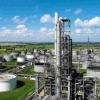Dear all,
When the temperature at relieving conditions for gas filled vessels exceeds 1100 deg. F, is it mandatory to install a pressure relief valve?
Thanks
smuk
|
|
Pressure Relief For Gas Filled Vessels
Started by smuk, Dec 10 2009 03:44 AM
5 replies to this topic
Share this topic:
#1

Posted 10 December 2009 - 03:44 AM
#2

Posted 10 December 2009 - 04:26 AM
You didn't specify but seems the situation you mentioned is fire case.Anyway as per ASME sec. VIII you have to consider PSV for your vessel if it is pressure vessel.
#3

Posted 10 December 2009 - 06:13 AM
If there is threat of overpressurizing the system, you need to provide overpressure protection means i.e. PSV, RD, etc.
Besides, if the system contains pressure vessel, in many event the code of design mandate provision of PSV or RD.
Besides, if the system contains pressure vessel, in many event the code of design mandate provision of PSV or RD.
#4

Posted 23 December 2009 - 02:47 PM
You can install a PSV but recognize that a PSV offers little to no real protection when gas filled vessels are exposed to fire. The vessel walls will continue to heat up and fail if exposed for a long enough period of time. Gas thermal expansion can't remove the heat from the fire. Only a boiling liquid can do that.
It was a gas-filled vessel, exposed to fire, that led to the creation of Code Case 2211. CC 2211 is now UG-140 in the body of ASME Sec VIII....that is, it's no longer a Code Case. Like CC2211, UG-140 can be applied to gas filled vessels exposed to fire.
Even though PSVs can't provide any real protection for vapor-filled vessels exposed to fire, there are other protectives measures that are effective and should be seriously considered. They are:
(1) water spray, or additional water spray
(2) fire resistant insulation, or additional insulation
(3) automatic de-pressurization
If you have no scenarios that can cause overpressure (including fire exposure), then you can consider using UG-140 to omit the relief dewvice. Alternatively, you can install a PSV, recognizing that it will probably not prevent the vessel from failing, and include one or more of the protective measures listed above.
By default, I prefer to install a small PSV on vessels that have no identifiable causes of overpressure, rather than applying UG-140. However, there many cases where it makes sense to use UG-140. For vapor-filled vessels exposed to fire, I don't like to give anyone the impression that a PSV provides any real protection from that scenario. It's important to bring this up with the client and to discuss effective alternate layers of protection.
It was a gas-filled vessel, exposed to fire, that led to the creation of Code Case 2211. CC 2211 is now UG-140 in the body of ASME Sec VIII....that is, it's no longer a Code Case. Like CC2211, UG-140 can be applied to gas filled vessels exposed to fire.
Even though PSVs can't provide any real protection for vapor-filled vessels exposed to fire, there are other protectives measures that are effective and should be seriously considered. They are:
(1) water spray, or additional water spray
(2) fire resistant insulation, or additional insulation
(3) automatic de-pressurization
If you have no scenarios that can cause overpressure (including fire exposure), then you can consider using UG-140 to omit the relief dewvice. Alternatively, you can install a PSV, recognizing that it will probably not prevent the vessel from failing, and include one or more of the protective measures listed above.
By default, I prefer to install a small PSV on vessels that have no identifiable causes of overpressure, rather than applying UG-140. However, there many cases where it makes sense to use UG-140. For vapor-filled vessels exposed to fire, I don't like to give anyone the impression that a PSV provides any real protection from that scenario. It's important to bring this up with the client and to discuss effective alternate layers of protection.
#5

Posted 23 December 2009 - 04:51 PM
I totally agree with Lowflo with everything he/she recommends - except the initial sentence: "You can install a PSV but recognize that a PSV offers little to no real protection when gas filled vessels are exposed to fire". My take on this is: "You have to install a PSV (as per ASME Section VIII) but recognize that a PSV offers little to no real protection when gas filled vessels are exposed to fire".
#6

Posted 28 December 2009 - 04:06 PM
Keep in mind too that there may be a possibility for some liquid to get into the vessel. Vessels poorly dried before startup or supposedly "dry" gases which actually contain some condensate may exist despite no evidence of these conditions in modeling efforts. If liquid can get into the vessel, and if it would be a bad thing for liquid to be present, then my advise would be to assume that the liquids are present. There's even a law for this - Murphy's Law.
Similar Topics
Recommended Installation Location For "pressure High" InterlocStarted by Guest_omupei_* , 20 Jun 2025 |
|

|
||
Parallel Control Valves Downstream Relief ScenarioStarted by Guest_pklavinsJ_* , 18 Jun 2025 |
|

|
||
Distillation Tower Top And Bottom Temperature And PressureStarted by Guest_student55_* , 27 Mar 2016 |
|
|
||
Steam Pressure In Heat ExchangerStarted by Guest_mvanrijnbach_* , 15 Apr 2025 |
|

|
||
Critical Pressure For Choke Valve SizingStarted by Guest_Sherif Morsi_* , 07 Nov 2017 |
|

|

 FB
FB









